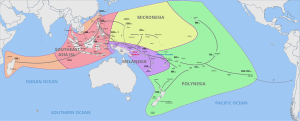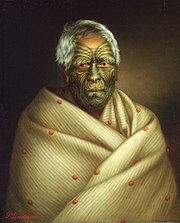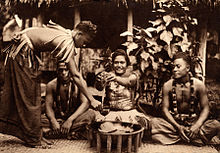Polynesians
This article may require copy editing for grammar, style, cohesion, tone, or spelling. (March 2024) |
| Total population | |
|---|---|
| c. 3,200,000 | |
| Regions with significant populations | |
| New Zealand | 1,157,478[1] |
| United States | 988,519[2] |
| Australia | 409,805 |
| French Polynesia | c. 215,000[3] |
| Samoa | 192,342 |
| Tonga | 103,036 |
| Cook Islands | 17,683 |
| Canada | 10,760[4] |
| Tuvalu | 10,645[5] |
| Chile | 9,399[6] |
| Languages | |
| Polynesian languages (Hawaiian, Māori, Rapa Nui, Samoan, Tahitian, Tongan, Tuvaluan and others), English, French and
Polynesian mythology[8] | |
| Related ethnic groups | |
| other Austronesian peoples, Euronesians | |
Polynesians are an
As of 2012[update] there were an estimated 2 million ethnic Polynesians (full and part) worldwide, the vast majority of whom either inhabit independent Polynesian nation-states (Samoa, Niue, Cook Islands, Tonga, and Tuvalu) or form minorities in countries such as Australia, Chile (Easter Island), New Zealand, France (French Polynesia and Wallis and Futuna), and the United States (Hawaii and American Samoa), in addition to the British Overseas Territory of the Pitcairn Islands. New Zealand had the highest population of Polynesians, estimated at 110,000 in the 18th century.[10]
Polynesians have acquired a reputation as great navigators—their canoes reached the most remote corners of the Pacific, allowing the settlement of islands as far apart as Hawaii, Rapanui (Easter Island) and Aotearoa (New Zealand).[11] The people of Polynesia accomplished this voyaging using ancient navigation skills of reading stars, currents, clouds and bird movements—skills passed to successive generations down to the present day.[12]
Origins

Polynesians, including

There are
The direct ancestors of the Polynesians are believed to be the
Genetic studies

Analysis by Kayser et al. (2008) discovered that only 21% of the Polynesian autosomal gene pool is of
Soares et al. (2008) have argued for an older pre-Holocene Sundaland origin in Island Southeast Asia (ISEA) based on mitochondrial DNA.[30] The "out of Taiwan model" was challenged by a study from Leeds University and published in Molecular Biology and Evolution. Examination of mitochondrial DNA lineages shows that they have been evolving in ISEA for longer than previously believed. Ancestors of the Polynesians arrived in the Bismarck Archipelago of Papua New Guinea at least 6,000 to 8,000 years ago.[31]
A 2014 study by Lipson et al. using
Other studies in 2016 and 2017 also support the implications that the earliest Lapita settlers mostly bypassed New Guinea, coming directly from
A 2020 study found that the Polynesians and the Indigenous peoples of South America, came in contact around 1200, centuries before Europeans interacted with either group.[38][39]
People



There are an estimated 2 million ethnic Polynesians and many of partial Polynesian descent worldwide, the majority of whom live in Polynesia, the United States, Australia and New Zealand.[40] The Polynesian peoples are shown below in their distinctive ethnic and cultural groupings (estimates of the larger groups are shown):
- Māori: New Zealand (Aotearoa) – c. 892,200,[41](not including 170,057 residing in Australia,[42] worldwide: c. 1,062,257)[43]
- Samoan: Samoa, American Samoa – c. 249,000 (worldwide: c. 500,000–600,000, including the 109,000 residing in the US and 145,000 in New Zealand)
- Tahitians (Maohi): Tahiti – c. 178,000 (including multiracial: 250,000+)
- Hawaiians: Hawaii– c. 140,000 (including multiracial: 400,000)
- Tongan: Tonga – c. 104,000 (worldwide: c. 300,000, including 43,465 residing in Australia, 67,221 in U.S.A, & 82,839 in New Zealand)
- Cook Islands Māori: Cook Islands – 98,000+ (including 62,000 in New Zealand and 16,000 residing in Australia)
- Niuean: Niue – c. 20,000–25,000 (95% of whom live in New Zealand)
- Rotumans: Rotuma – c. 15,000–20,000 (5% reside on Rotuma Island, 75% live on mainland Fiji and 20% live elsewhere (specifically in Australia and New Zealand)
- Tuvaluan: Tuvalu – c. 10,000 (+ 3,500 in New Zealand)
- Tokelauan: Tokelau – c. 1,500 (+ 6,500 in New Zealand)
- Tuamotu: Tuamotu Archipelago – c. 16,000
- Marquesas Islanders: Marquesas Islands – c. 11,000
- Rapanui: Easter Island– c. 5,000 (including mixtures and those living in Chile)
- Austral Islanders: Austral Islands – ~7,000
- Mangareva: Gambier Islands – c. 1,600
- Rēkohu) – c. 738 (2013 New Zealand Census)
- Uvea and Futuna: Wallis and Futuna
- The Federated States of Micronesia
- Takuu: Papua New Guinea
- Vaeakau-Taumako: Solomon Islands
- Fagauvea: Ouvéa (New Caledonia)
See also
References
- ^ Population Movement in the Pacific: A Perspective on Future Prospects. Wellington: New Zealand Department of Labour Archived 7 February 2013 at the Wayback Machine
- ^ "Chuukese and Papua New Guinean Populations Fastest Growing Pacific Islander Groups in 2020".
- ^ Landfalls of Paradise: Cruising Guide to the Pacific Islands, Earl R. Hinz & Jim Howard, University of Hawaii Press, 2006, page 80.
- ^ "Census Profile, 2016 Census". 8 February 2017.
- ^ "Population of communities in Tuvalu". world-statistics.org. 11 April 2012. Retrieved 20 March 2016.
- ^ "Síntesis de Resultados Censo 2017" (PDF). Instituto Nacional de Estadísticas, Santiago de Chile. p. 16.
- ^ Christianity in its Global Context, 1970–2020 Society, Religion, and Mission, Center for the Study of Global Christianity
- ^ Wellington, Victoria University of (1 December 2017). "Arts, humanities and social sciences". victoria.ac.nz. Archived from the original on 13 April 2016. Retrieved 14 April 2018.
- ^ "Māori population estimates: At 30 June 2022". www.stats.govt.nz. Retrieved 31 January 2023.
- ^ King, Michael (2003). The Penguin History of New Zealand. London: Penguin. p. 91.
- PMID 21187404.
- ^ DOUCLEFF, MICHAELEEN (23 January 2013). "How The Sweet Potato Crossed The Pacific Way Before The Europeans Did". NPR. Retrieved 25 January 2020.
- ISBN 9781920942854.
- PMC 1166355.
- ^ "Pacific People Spread From Taiwan, Language Evolution Study Shows". ScienceDaily. 27 January 2009. Retrieved 29 April 2010.
- ^ Pietrusewsky, Michael (2006). "Initial Settlement of remote Oceania: the evidence from physical anthropology". In Simanjuntak, T.; Pojoh, I.H.E.; Hisyam, M. (eds.). Austronesian Disapora and the Ethnogenesis of People in Indonesian Archipelago. Proceedings of the International Symposium. Jakarta: LIPI Press. pp. 320–347.
- ISBN 978-0470016176.
- ^ Dr. Martin Richards. "Climate Change and Postglacial Human Dispersals in Southeast Asia". Oxford Journals. Retrieved 1 January 2010.
- S2CID 57559261.
- S2CID 164373747.
- ISBN 9781760460952.
- S2CID 128641903.
- PMID 18179899.
- PMID 18208337.
- ^ Assessing Y-chromosome Variation in the South Pacific Using Newly Detected, By Krista Erin Latham
- PMID 34552258.
- PMID 9671802.
- PMID 15280221.
- PMID 6777243.
- ^ Martin Richards. "Climate Change and Postglacial Human Dispersals in Southeast Asia". Oxford Journals. Retrieved 28 March 2017.
- ^ DNA Sheds New Light on Polynesian Migration, by Sindya N. Bhanoo, Feb. 7, 2011, The New York Times
- PMID 25137359.
- PMID 25137359.
- PMID 16923821.
- PMID 27698418.
- PMID 27698418.
- ^ "First ancestry of Ni-Vanuatu is Asian: New DNA Discoveries recently published". Island Business. December 2016. Archived from the original on 30 July 2018. Retrieved 11 January 2017.
- ^ "DNA reveals Native American presence in Polynesia centuries before Europeans arrived". Archived from the original on 10 July 2020.
- PMID 32641827.
- ^ "The Pacific Islands & New Zealand".
- ^ "Māori population estimates: At 30 June 2022 | Stats NZ". www.stats.govt.nz. Retrieved 31 January 2023.
- ^ "Ancestry | Australia | Community profile". profile.id.com.au. Retrieved 1 February 2023.
- ^ "Cultural diversity: Census, 2021 | Australian Bureau of Statistics". www.abs.gov.au. 12 January 2022. Retrieved 31 January 2023.
External links
 Media related to People of Polynesia at Wikimedia Commons
Media related to People of Polynesia at Wikimedia Commons

